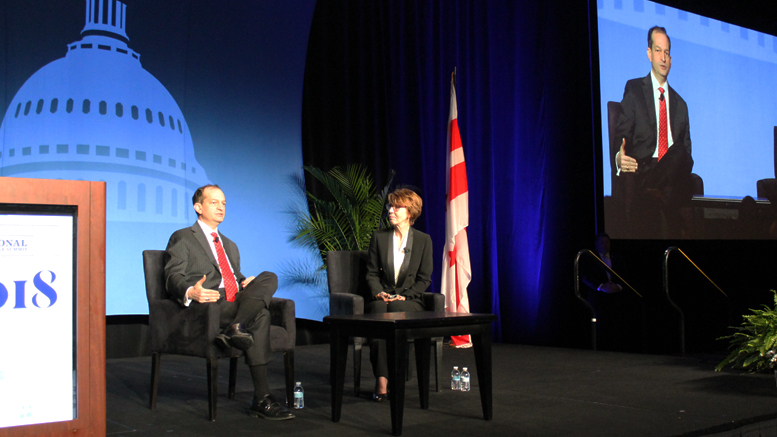U.S. Labor Secretary Alexander Acosta wants to break down the silos that delineate workforce training, workforce development, technical education and traditional education.
“I would argue this is one continuum,” he said Monday at the annual National Legislative Summit in Washington, D.C., which is presented by the Association of Community College Trustees in collaboration with the American Association of Community Colleges (AACC).
“Everyone needs practical skills, experience and theoretical knowledge at the same time. That’s what you do,” Acosta said.
While the nation has a strong economy and a low unemployment rate, there are still 6 million job openings, he said, noting that employers are having trouble finding people with the right skills for good, family-sustaining jobs.
Today’s jobs demand continuous upskilling, he said. “We need to focus on demand-driven education,” where employees “learn while they earn.”
More apprenticeships needed
Many community colleges are already creating successful apprenticeship programs in partnerships with employers, he said.
Chaffey College in California, for example, is partnering with the steel industry and U.S. Department of Labor (DOL) on an apprenticeship program that has energized students and faculty. One Chaffey student told Acosta: “I can now not only support my family and I not only have a job, but I now have a career path,” he recalled. “That was transformative for that person.”
Acosta spoke of another student who was homeless but learned HVAC skills at a Nevada community college, found a job paying $12 an hour and for the first time could afford an apartment.
According to Acosta, apprenticeship programs “position students for lifelong learning and lifelong earning.”
The expansion of apprenticeship programs is a key goal of the Trump administration, which wants employers to have more flexibility to create industry-recognized apprenticeships. AACC President Walter G. Bumphus serves on the federal Task Force on Apprenticeship Expansion, and last month AACC and DOL signed a memorandum of understanding calling for the two groups to work together in support of new, innovative apprenticeships.
Acosta would like to see the process of creating and endorsing apprenticeships decentralized, with DOL “taken out of the loop,” Acosta said. “Our hope is you will engage with third-party certifiers.”
Up to now, most apprenticeships in the U.S. have been in the building trades, but that idea of learning while doing can apply to all sectors, he said. Medical schools require students to go on rounds as well as learn in the classroom, for example, while aspiring teachers have to take part in classroom experiences. The same could apply for prospective accountants, architects and other professionals, he said.
Break down the silos
The average salary for someone who completes an apprenticeship program is $60,000, Acosta noted, while someone starting out as welder can earn as much as a newly minted lawyer, but without the debt.
In an increasingly individualized workforce, people are choosing their own career path, Acosta said. For some that could be certificate, while others pursue an associate degree or higher.
For most people, education is a path to a job, and the promise of employment is a strong incentive to complete an education, he said. To encourage more people to get on that path, “we need to break down the barriers to create an educational continuum.”

